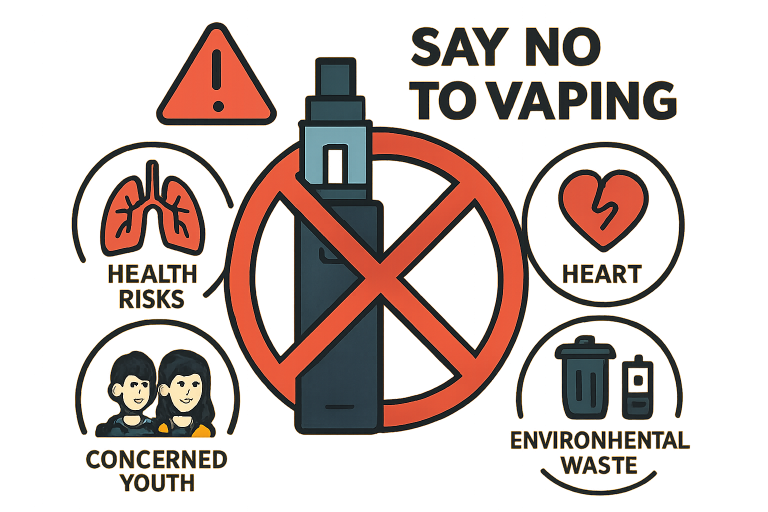Vaping Risks: What You Should Know
Vaping, once advertised as a safer substitute for traditional cigarettes, has become a cultural phenomenon, especially among teenagers and young adults. These sleek, easy-to-conceal devices have rapidly gained popularity, but beneath the surface of clever marketing lies mounting scientific evidence that highlights serious risks. Before assuming switching to e-cigarettes is risk-free, it’s crucial to understand and examine the whole story about why vapes aren’t a safe smoking alternative. The widely held perception that vaping is harmless is contradicted by robust research that uncovers significant health repercussions, environmental consequences, and societal costs associated with the use of e-cigarettes.
The explosive popularity of vaping has created ripple effects that extend well beyond individual users themselves—the distinctive patterns of addiction, the mounting environmental toll of single-use vapes, and the risks posed to bystanders are all critical issues that demand attention. Both the immediate and the long-term risks must be considered for anyone weighing e-cigarettes as a so-called “safer” option. Vaping is not simply a new way to consume nicotine; it is a public health challenge interwoven with addiction, environmental waste, and a profound need for education and regulation.
Understanding the Health Implications
Although e-cigarettes generally contain fewer toxic chemicals than combustible tobacco, they release an aerosol that contains harmful substances such as nicotine, formaldehyde, and acrolein—each of which brings its health dangers. Nicotine, the primary addictive component in tobacco, is extremely habit-forming and especially hazardous to developing adolescent brains, with evidence showing potential impacts on attention, learning, and impulse control. Inhaling juices and aerosols from vapes can also irritate and permanently damage sensitive lung tissue, raising the risk of chronic bronchitis and even life-threatening lung injuries in some users. Furthermore, emerging scientific research continues to reveal potential links between frequent vaping and increased risks for cardiovascular conditions and respiratory diseases. The health risks associated with e-cigarette use extend beyond just the headline-grabbing lung injuries and addiction; they encompass a range of developing complications that researchers are still working to understand fully.
The Appeal to Youth and Resulting Epidemic
Flavor Marketing and Nicotine Addiction
Perhaps the most striking and disturbing aspect of the vaping epidemic is its impact on youth. A defining feature of the industry is its focus on sweet and exotic flavors—such as mango, mint, cotton candy, and bubble gum—which has proven highly effective at enticing first-time users, often teenagers. These flavors mask the bitter taste of nicotine, making the experience more appealing and less harsh, thus encouraging experimentation and, ultimately, dependence. This accessibility and palatability lower the barrier for trying nicotine-based products and dramatically increase the risk of a new generation becoming addicted. The result: a troubling escalation in youth nicotine dependence that has immense consequences for public health and places additional strain on schools, families, and medical resources.
Regulatory Response
Recognizing the growing threat, government bodies and health organizations have escalated their regulatory scrutiny. For instance, New York State has launched high-profile lawsuits against vape distributors accused of targeting teens with irresponsible marketing and of allowing flavored products to proliferate. These legal actions represent just one frontline in the effort to protect youth, as lawmakers confront industry practices that prioritize profit and innovation over public health. Regulatory responses often include strict age limits, flavor bans, and ongoing investigations into deceptive advertising. Policy interventions, while essential, must also be complemented by comprehensive educational campaigns to counter misinformation and raise awareness among young people and their families.

Environmental Concerns
Beyond health, e-cigarettes pose a unique set of environmental challenges that are often overlooked. Many vaping devices—especially disposable versions—are designed for single use, resulting in a surge of electronic waste that includes plastics, heavy metals, lithium batteries, and poisonous remnants of nicotine-laden liquids. Unlike traditional cigarette butts, which are notorious pollutants themselves, e-cigarette waste does not biodegrade quickly. It can leach hazardous materials into local water and soil, causing harm to wildlife and contaminating sensitive ecosystems. Batteries left in landfills can leak dangerous substances, and the plastic casings add to the microplastics that pollute oceans and food chains. The assembly of different components—such as metal coils, circuit boards, and e-liquid pods—makes recycling especially challenging, often leading to improperly discarded devices piling up in landfills or on streets. Every step in the e-cigarette life cycle, from production to disposal, can exacerbate pollution and deplete valuable natural resources. Discover more about the environmental impact of electronic cigarettes. These mounting issues highlight the urgent need for stricter regulations and industry accountability in managing vape-related waste. Without proper intervention, the environmental toll of e-cigarettes will only continue to grow alongside their popularity.
Challenges in Quitting Vaping
Nicotine Dependence and Cessation Obstacles
The discreet and technologically advanced design of modern vaping devices allows for repeated use throughout the day. Because vapes often deliver higher concentrations of nicotine than combustible cigarettes and are consumed casually—sometimes even in settings where smoking is prohibited—users may quickly develop a strong physical and psychological dependency. The continual availability of nicotine through vapes makes it hard for individuals to monitor or moderate their intake, and this barrier to abstaining can fuel continued addiction. The psychological ritual of vaping, the flavors, and the convenience all combine to make quitting more complex than many users anticipate.
Cessation Resources and Gaps
Despite an increasing number of vapers—especially teenagers—wanting to quit, support systems explicitly tailored for e-cigarette cessation are underdeveloped. While strategies such as digital apps, nicotine replacement therapies, and behavioral counseling provide some assistance, these resources were initially designed with cigarette smokers in mind. They may not always address the unique triggers or patterns associated with vaping. The gaps in cessation resources mean that many users are left unsupported or relying on improvisational solutions that may not be effective. As the vaping epidemic continues, health professionals and policymakers must create and invest in innovative, targeted programs that help people break free of e-cigarette addiction. For more about the challenges involved in quitting, see this helpful guide to quitting vaping. These programs should be grounded in research that reflects the specific behavioral and psychological dynamics of vaping. Only by addressing the unique needs of e-cigarette users can we begin to close the growing gap in cessation support.
Secondhand Exposure Risks
A common and dangerous misconception about vaping is that the aerosol released is just harmless water vapor. In truth, the exhaled vapor contains not only nicotine, but also ultrafine particles, heavy metals like lead, and toxic chemicals—all of which can be inhaled by anyone close to the user. Those most at risk include children, pregnant people, and individuals living with chronic respiratory conditions such as asthma or COPD. In environments where vaping occurs regularly, vulnerable populations can be exposed to both acute symptoms—like headaches and respiratory irritation—as well as long-term health effects that remain under-researched but concerning. This makes secondhand exposure a significant issue for families, workplaces, and communities alike, highlighting the need for clearer policies and better public understanding of the risks.
Conclusion
Vaping may have been introduced—and often aggressively marketed—as a safer alternative to traditional smoking, but the facts expose a much darker reality. These products pose substantial health risks, create significant environmental issues, and exploit youth curiosity through targeted marketing and enticing flavors. The aerosol impacts not just the user but everyone in their immediate environment, amplifying the need for better education, stricter regulation, and broader access to cessation resources. Raising awareness and promoting honest education about the risks associated with vaping is essential—not only for individuals, but also for families, schools, and public health leaders. If you or someone you care about is struggling to quit, reach out for professional support—taking the step toward cessation is an investment that pays dividends for your health, your loved ones, and the future of the broader community.


